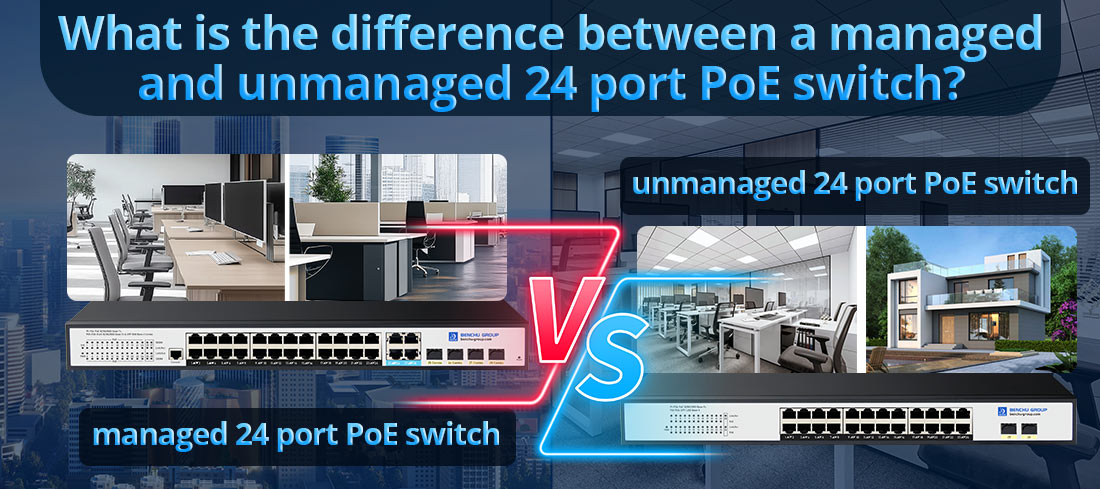
Разница между управляемым и неуправляемым 24-портовым коммутатором PoE заключается в их функциональности, управлении и возможностях. Ниже приведено подробное описание каждого типа, их различий и лучших вариантов использования.
1. Неуправляемый 24-портовый коммутатор PoE
--- Ан неуправляемый коммутатор PoE — это устройство Plug-and-Play, которое предлагает базовые возможности подключения и подачу питания PoE без каких-либо дополнительных параметров конфигурации.
Ключевые особенности:
--- Простота использования: Просто подключите свои устройства, и коммутатор автоматически обнаружит и подаст питание на PoE-совместимые устройства.
--- Нет конфигурации: Нет веб-интерфейса или интерфейса командной строки для настройки или управления.
--- Фиксированные настройки: Порты работают с заранее заданными настройками (например, скоростью, распределением мощности, качеством обслуживания).
--- Доставка питания PoE: Обеспечивает питание подключенных устройств в зависимости от общего бюджета PoE коммутатора и ограничений для каждого порта.
Нет расширенных сетевых функций:
--- Нет поддержки VLAN.
--- Нет приоритизации трафика.
--- Никаких инструментов мониторинга или устранения неполадок.
Преимущества:
--- Экономичность: Дешевле, чем управляемые коммутаторы.
--- Простое развертывание: Идеально подходит для небольших сетей или установок, требующих минимальных технических знаний.
--- Надежность: Меньше функций означает меньше возможностей для неправильной настройки.
Лучшие варианты использования:
--- Малый бизнес или домашние сети.
--- Сети с базовыми требованиями PoE (например, питание IP-камер, VoIP-телефонов или простых точек доступа).
--- Среды, в которых дополнительные функции, такие как контроль и мониторинг трафика, не нужны.
2. Управляемый 24-портовый коммутатор PoE
--- А управляемый коммутатор PoE предлагает обширный контроль над сетью, позволяя выполнять детальную настройку, мониторинг и устранение неполадок.
Ключевые особенности:
Дополнительные параметры конфигурации:
--- Сети VLAN: Сегментируйте сеть для лучшей изоляции трафика и безопасности.
--- QoS (качество обслуживания): Расставьте приоритеты для критического трафика (например, VoIP, видеопотоков).
--- Агрегация ссылок: Объедините несколько портов для увеличения пропускной способности.
--- Зеркальное отображение портов: Мониторинг определенных портов для устранения неполадок.
Управление PoE:
--- Управление питанием для каждого порта: Включите/отключите PoE на отдельных портах.
--- Планирование мощности: Автоматическое включение/выключение устройств в определенное время.
--- Приоритеты мощности: Убедитесь, что критически важные устройства получают питание в первую очередь во время перебоев с питанием.
Мониторинг и устранение неполадок:
--- Мониторинг трафика в реальном времени (например, через SNMP или веб-интерфейс).
--- Диагностика и протоколирование ошибок.
--- Удаленный доступ для обслуживания и обновлений.
Функции безопасности:
--- Списки контроля доступа (ACL).
--- Безопасность порта для предотвращения несанкционированного доступа.
--- Защита от сетевых петель или широковещательных штормов.
--- Масштабируемость и гибкость: легко адаптируйте коммутатор к будущему расширению или изменению сети.
Преимущества:
--- Полный контроль сети: Обеспечивает детальный контроль над трафиком и управлением питанием.
--- Повышенная безопасность: Защищает от несанкционированного доступа и уязвимостей сети.
--- Оптимизация: Обеспечивает эффективное использование полосы пропускания и энергоресурсов.
--- Перспективность: Масштабируемость для растущих сетей.
Лучшие варианты использования:
--- Средние и крупные предприятия или предприятия.
--- Сети с разнообразными устройствами (например, IP-камерами высокого разрешения, усовершенствованными точками доступа, устройствами Интернета вещей).
--- Среды, требующие сегментации трафика, определения приоритетов или расширенного устранения неполадок.
--- Критически важные сети, для которых важны бесперебойная работа и производительность.
Ключевые различия между управляемыми и неуправляемыми 24-портовыми коммутаторами PoE
| Особенность | Неуправляемый коммутатор PoE | Управляемый коммутатор PoE |
| Настраивать | Plug-and-play, без настройки. | Требует первоначальной настройки. |
| Контроль | Никакого пользовательского контроля. | Полный контроль над портами, трафиком и питанием. |
| Поддержка VLAN | Нет в наличии. | Поддерживает сегментацию VLAN. |
| Управление трафиком | Никто. | QoS, контроль пропускной способности, агрегация каналов. |
| Управление PoE | Только автоматическое распределение мощности. | Управление питанием каждого порта, планирование, приоритезация. |
| Мониторинг | Никаких инструментов мониторинга. | Мониторинг в реальном времени, SNMP и ведение журнала. |
| Безопасность | Минимальный (базовый функционал порта). | Расширенные функции безопасности (списки ACL, безопасность портов). |
| Расходы | Ниже. | Выше. |
| Варианты использования | Маленькие, простые сети. | Большие, сложные или растущие сети. |
Как выбрать между управляемым и неуправляемым 24-портовые коммутаторы PoE
Выбирайте неуправляемый коммутатор, если:
--- Вам нужно экономичное решение для простой сети.
--- В сети имеются базовые устройства, не требующие сегментации трафика или приоритезации.
--- Вы предпочитаете минимальную настройку без технических знаний.
Выбирайте управляемый коммутатор, если:
--- Ваша сеть имеет сложные требования, такие как VLAN или QoS.
--- Вам необходим централизованный контроль и мониторинг устройств и трафика.
--- Безопасность и масштабируемость имеют решающее значение для вашей сети.
--- У вас есть ИТ-ресурсы или опыт для настройки и обслуживания.
Заключение
--- Неуправляемый 24-портовый PoE-переключатель идеально подходит для небольших или базовых сетей с минимальными требованиями.
--- Управляемый 24-портовый коммутатор PoE лучше всего подходит для средних и крупных сетей или сред, требующих гибкости, контроля и расширенных функций.
Учитывая сложность вашей сети, потребности в масштабируемости и доступные ресурсы, вы можете выбрать коммутатор, который лучше всего соответствует вашим целям.